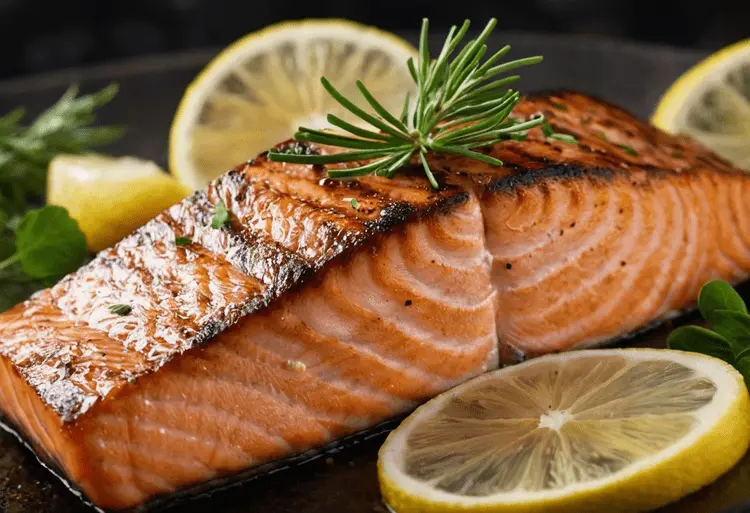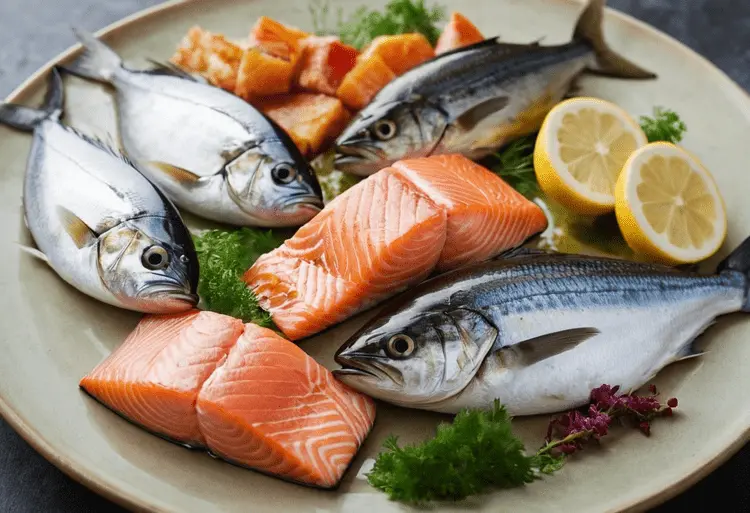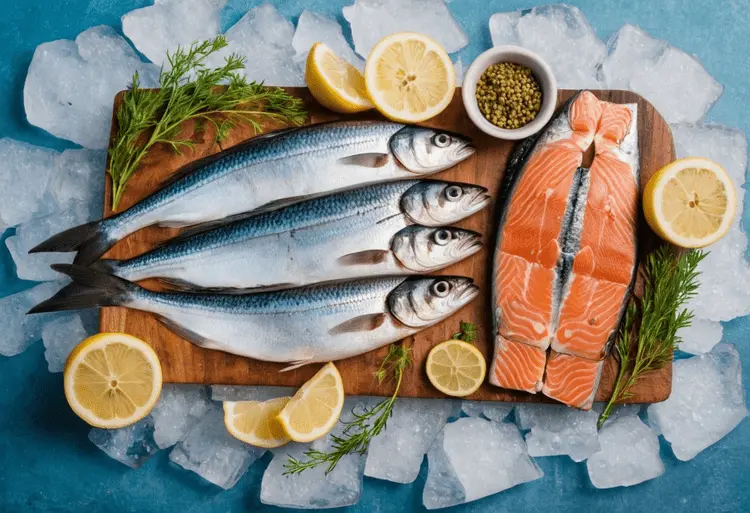Fatty fish: Your secret weapon for a healthier heart and sharper mind? Absolutely!
These oily fish, packed with omega-3 fatty acids – specifically EPA and DHA – are nutritional powerhouses that offer a wealth of benefits for your body and mind.
From reducing the risk of heart disease and improving brain health to fighting inflammation and boosting mood, the science-backed advantages of incorporating fatty fish into your diet are undeniable.
In this guide, we’ll delve into the world of heart-healthy, brain-boosting fatty fish, exploring the different types, their nutritional profiles, delicious recipes, and the importance of choosing sustainable seafood options.
Get ready to discover why omega-3 rich fish like salmon, tuna, mackerel, and sardines deserve a prominent place on your plate.
Fatty Fish in a Nutshell
- Omega-3 powerhouse
- Heart & brain health
- Multiple benefits
- Delicious & versatile
- Choose sustainable options
Table of contents
Introduction & The Omega-3 Advantage

What Makes Fatty Fish So “Fatty?”
Have you ever wondered what sets fish apart from their leaner counterparts? It’s not just the taste, but a secret ingredient called omega-3 fatty acids.
These fats aren’t the kind that clog your arteries; they’re the superstars that nourish your heart, brain, and whole body.
Omega-3 Fatty Acids: The Essential Nutrient Your Body Craves
Omega-3s, especially EPA and DHA, are essential fats that our bodies can’t produce on their own. This makes fish like salmon, tuna, mackerel, and sardines our lifeline to this vital nutrient.
They’re not just a tasty meal, they’re a health powerhouse packed with benefits you won’t find in a supplement bottle.
Curious about the specific benefits of these remarkable fats? The American Heart Association provides a detailed explanation of how Omega-3 Fatty Acids make an essential contribution to our well-being.
Beyond Health: Your Sustainable Seafood Choices
But there’s more to the story. As we indulge in the deliciousness of fatty fish, it’s crucial to make informed choices. Sustainability is key to ensuring these omega-3 powerhouses are available for generations to come.
Are you passionate about protecting our oceans? Let’s dive into the world of sustainable seafood together and discover how you can make a difference with every bite.
We’re just getting started! This is your ultimate guide to those fish, where we’ll explore their incredible health benefits, the best types to eat, delicious recipes, and how to choose sustainable options.
Join the conversation, share your favorite fish dishes, and tag us on social media – we can’t wait to hear from you!
Loved the omega-3 boost from fatty fish? Now, let’s dive deeper into the world of cholesterol-lowering foods! Discover how to build a heart-healthy plate packed with flavor and nutrients.
The Health Benefits of Fatty Fish
Ever wonder why fatty fish like salmon and tuna are hailed as nutritional superstars? Let’s dive deeper into the amazing ways these omega-3 powerhouses can transform your health.
Heart Health: Beyond Cholesterol
Sure, you’ve heard fatty fish is good for your heart, but did you know it goes beyond cholesterol? Omega-3 fatty acids are like tiny firefighters, quenching inflammation throughout your body.
This means lower blood pressure, healthier triglyceride levels, and a reduced risk of heart disease, stroke, and those pesky irregular heartbeats.
Brain Boost: Cognitive Power & Mood
Have you ever felt a mental fog after a long day? Fatty fish might be your brain’s best friend. Omega-3s are crucial for brain development and function at every stage of life.
Studies suggest they may help with depression, anxiety, ADHD, and even protect against dementia.
Need a mental pick-me-up? Grab a salmon salad or tuna sandwich, and feel the brainpower surge! Don’t forget to share your experience with us on social media – we love hearing your success stories.
More Than Just the Heart & Brain
The benefits of fatty fish don’t stop at the heart and brain. Let’s explore some more exciting perks:
- Eye Health: Protect those peepers from age-related macular degeneration.
- Joint Health: Ease the discomfort of rheumatoid arthritis.
- Skin Health: Enjoy a natural glow thanks to reduced inflammation.
- Immune System Support: Give your body’s defense system a boost.
- Pregnancy & Infancy: Essential for fetal brain and eye development.
Feeling curious? For a deeper dive into the science behind omega-3s, check out this comprehensive resource: Omega-3 Fatty Acids: An Essential Contribution. Let’s keep the conversation going – share your thoughts and questions in the comments below.
Nutritional Powerhouse: A Closer Look
Wondering how much goodness you’re getting from that serving of salmon? Here’s a peek at the nutritional profile of a 3-ounce (85g) cooked portion:
- Calories: Approximately 200
- Protein: Around 22-25g
- Fat: 11-14g (mostly healthy unsaturated fats)
- Omega-3s: 1.1-1.9g EPA and DHA
- Vitamins: B12, D, and other B vitamins
- Minerals: Selenium, potassium, and iodine
This nutrient-packed profile makes fatty fish an excellent addition to a healthy diet. Whether you’re aiming to lose weight, build muscle, or simply feel your best, these fish can be a delicious and satisfying way to fuel your body.
Choosing & Cooking Fatty Fish: A Flavorful Journey

Ready to embark on a culinary adventure? Let’s dive into the diverse world of fatty fish, where taste and nutrition intersect.
Types of Fatty Fish: A Culinary Tour
Ever wondered what sets salmon apart from tuna, or why mackerel is a sustainable superstar?
Let’s uncover the unique personalities of popular fatty fish:
- Salmon: Is wild-caught salmon always superior to farmed? What’s the deal with sockeye, king, and coho varieties? We’ll break down the nutritional differences and cooking tips. Check out the Monterey Bay Aquarium Seafood Watch guide for sustainable choices.
- Tuna: Curious about the different species and those pesky mercury concerns? We’ll delve into the world of albacore, skipjack, and bluefin, guiding you toward safe and delicious options. Learn more about the role of omega-3 fatty acids in your diet here: [Omega-3 Fatty Acids: An Essential Contribution]
- Mackerel: Should you choose Atlantic or King? We’ll reveal the sustainability secrets of this flavorful fish and share mouthwatering recipes. For a deeper understanding of responsible seafood choices, explore [Sustainable Seafood: A Guide to Making Responsible Choices].
- Sardines: Fresh or canned, these tiny powerhouses pack a nutritional punch. Discover their surprising benefits and tasty ways to enjoy them.
- Trout: Rainbow or brown? Let’s explore their unique flavors and best cooking methods.
- Herring: Pickled, smoked, or something else? We’ll unravel the culinary possibilities of this often-overlooked fish.
Cooking Tips & Flavor Pairings
Grilled, baked, or pan-seared? The possibilities are endless!
Here are some foolproof techniques and delicious combinations to elevate your fatty fish dishes:
- Grilling: High heat and quick cooking time are key.
- Baking: Pair with herbs and citrus for a fragrant and flavorful meal.
- Pan-searing: Achieve a crispy skin and tender flesh.
- Flavor Pairings: Lemon, dill, garlic, ginger, soy sauce, and miso are all fantastic complements to fatty fish.
Feel free to share your favorite fatty fish recipes and cooking tips in the comments below!
Nutrition Facts for Health-Conscious Foodies
Curious about the nutritional breakdown of your favorite fatty fish?
Here’s a quick guide per 3-ounce (85g) serving:
- Salmon: Calories: 120-200, Protein: 17-25g, Fat: 5-13g (mostly healthy fats!)
- Tuna: Calories: 110-180, Protein: 22-28g, Fat: 1-10g (varies by species)
- Mackerel: Calories: 200-260, Protein: 19-26g, Fat: 14-20g
- Sardines: Calories: 190-250, Protein: 21-28g, Fat: 11-17g
- Trout: Calories: 150-200, Protein: 20-25g, Fat: 8-12g
- Herring: Calories: 170-230, Protein: 19-25g, Fat: 10-15g
Please note that these are approximate values and can vary depending on the species and cooking method.
Addressing Concerns & Making Informed Decisions
Mercury: Friend or Foe in Fatty Fish?
Mercury in fish – a concern we’ve all heard whispers of. But what’s the real story? Is it a dealbreaker for enjoying fatty fish?
Truthfully, mercury levels vary widely between species. Smaller fish like sardines and herring are naturally low in mercury, while larger predators like tuna might contain more. The key? Moderation and informed choices.
The Omega-3 Question: Supplement vs. The Real Deal (Fatty Fish)
Let’s talk omega-3s. Supplements are convenient, but can they truly replace the benefits of whole, fatty fish?
Research suggests that while both provide omega-3s, whole fish offers additional nutrients like protein, vitamin D, and selenium. Plus, there’s something undeniably satisfying about savoring a perfectly cooked salmon fillet, wouldn’t you agree?
Let’s Chat!
Got more questions about fatty fish? Drop a comment below or tag us on social media. We love hearing from our readers!
Conclusion: Embrace the Power of Fatty Fish

Are you ready to transform your health with the incredible power of fatty fish? It’s not just about the delightful flavors and culinary adventures – it’s about unlocking a treasure trove of essential nutrients that can fuel your body and mind.
From safeguarding your heart and sharpening your brain to nourishing your skin and bolstering your immune system, the benefits of incorporating these omega-3 powerhouses into your diet are undeniable.
Remember, it’s not about eating a mountain of fish, but rather making informed choices about the types you consume and how often.
And speaking of informed choices, have you explored the Monterey Bay Aquarium Seafood Watch guide yet? It’s an invaluable resource for understanding the sustainability of different fatty fish options.
Now that you’re armed with knowledge, here’s a question: How are you planning to add more omega-3 goodness to your plate?
Let me know in the comments below! Share your favorite recipes, tips, or any questions you have about incorporating fatty fish into a balanced and healthy lifestyle.
Bonus Tip: For those who track their macros, a typical 3-ounce (85g) serving of cooked fatty fish contains roughly:
- Calories: 150-200
- Protein: 20-25g
- Fat: 5-10g (mostly unsaturated)
- Carbs: 0g
Craving an even bigger health boost? Discover the power of the carnivore diet and its potential benefits for weight loss, energy, and gut health.
Fatty Fish FAQs: Your Burning Questions Answered
Fatty fish are those with higher oil content in their flesh, like salmon, mackerel, and sardines.
“Oily fish” is another term for “fatty fish.” They are the same thing!
Salmon, tuna, mackerel, sardines, herring, and trout are among the most popular choices.
Yes, some types of tuna are considered fatty fish, especially varieties like albacore and bluefin.
Aim for two servings a week, roughly the size of a deck of cards each.
Both! Canned fish is often packed with bones, offering a calcium boost. Just watch out for added salt or oil.
It’s possible to overdo omega-3s, so stick to recommended servings and talk to your doctor if you have concerns.
While plant sources like flaxseeds and chia offer ALA (a type of omega-3), they don’t convert efficiently to the EPA and DHA found in fish.
Sardines, mackerel, and herring are nutritious and often more affordable than salmon.